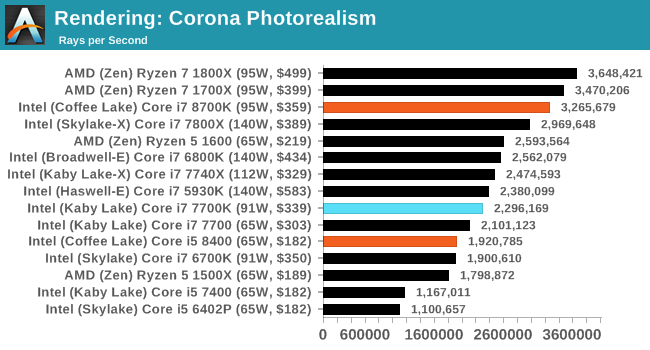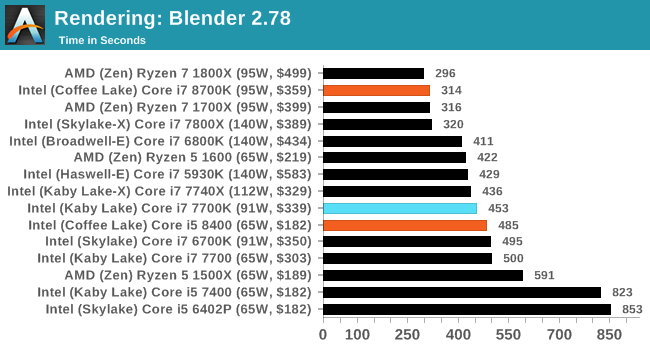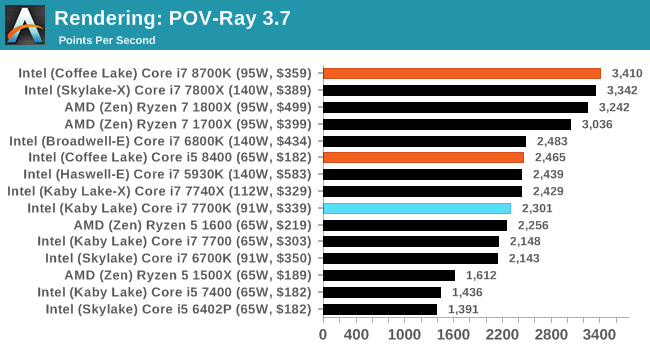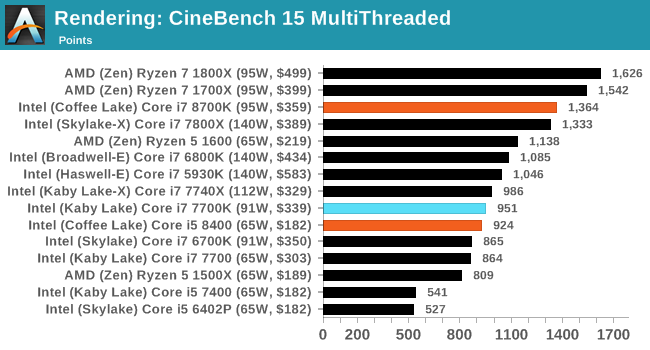The AnandTech Coffee Lake Review: Initial Numbers on the Core i7-8700K and Core i5-8400
by Ian Cutress on October 5, 2017 9:00 AM EST- Posted in
- CPUs
- Intel
- Core i5
- Core i7
- Core i3
- 14nm
- Coffee Lake
- 14++
- Hex-Core
- Hyperthreading
Benchmarking Performance: CPU Rendering Tests
Rendering tests are a long-time favorite of reviewers and benchmarkers, as the code used by rendering packages is usually highly optimized to squeeze every little bit of performance out. Sometimes rendering programs end up being heavily memory dependent as well - when you have that many threads flying about with a ton of data, having low latency memory can be key to everything. Here we take a few of the usual rendering packages under Windows 10, as well as a few new interesting benchmarks.
All of our benchmark results can also be found in our benchmark engine, Bench.
Corona 1.3: link
Corona is a standalone package designed to assist software like 3ds Max and Maya with photorealism via ray tracing. It's simple - shoot rays, get pixels. OK, it's more complicated than that, but the benchmark renders a fixed scene six times and offers results in terms of time and rays per second. The official benchmark tables list user submitted results in terms of time, however I feel rays per second is a better metric (in general, scores where higher is better seem to be easier to explain anyway). Corona likes to pile on the threads, so the results end up being very staggered based on thread count.

With more threads on display, the Core i7-8700K gets ahead of the previous mainstream Core i7 parts. The frequency difference over the Skylake-X processor gives an extra +10% performance, but the 16-thread parts from AMD win out overall.
Blender 2.78: link
For a render that has been around for what seems like ages, Blender is still a highly popular tool. We managed to wrap up a standard workload into the February 5 nightly build of Blender and measure the time it takes to render the first frame of the scene. Being one of the bigger open source tools out there, it means both AMD and Intel work actively to help improve the codebase, for better or for worse on their own/each other's microarchitecture.

Blender seems to separate very nicely into core counts, with six cores from Intel matching eight cores from AMD.
LuxMark v3.1: Link
As a synthetic, LuxMark might come across as somewhat arbitrary as a renderer, given that it's mainly used to test GPUs, but it does offer both an OpenCL and a standard C++ mode. In this instance, aside from seeing the comparison in each coding mode for cores and IPC, we also get to see the difference in performance moving from a C++ based code-stack to an OpenCL one with a CPU as the main host.

POV-Ray 3.7.1b4: link
Another regular benchmark in most suites, POV-Ray is another ray-tracer but has been around for many years. It just so happens that during the run up to AMD's Ryzen launch, the code base started to get active again with developers making changes to the code and pushing out updates. Our version and benchmarking started just before that was happening, but given time we will see where the POV-Ray code ends up and adjust in due course.

Cinebench R15: link
The latest version of CineBench has also become one of those 'used everywhere' benchmarks, particularly as an indicator of single thread performance. High IPC and high frequency gives performance in ST, whereas having good scaling and many cores is where the MT test wins out.


CineBench R15 in single thread mode can take the Core i7-8700K by the horns and drag it to be the best performing chip ever tested.










222 Comments
View All Comments
Koenig168 - Friday, October 6, 2017 - link
Hmm ... rather disappointing that Anandtech did not include Ryzen 1600/X until called out by astute readers.mkaibear - Friday, October 6, 2017 - link
...apart from including all the data in their benchmark tool, which they make freely available, you mean? They put in the CPUs they felt that were most relevant. The readership disagreed, so they changed it from their benchmark database. That level of service is almost unheard of in the industry and all you can do is complain. Bravo.Koenig168 - Friday, October 6, 2017 - link
Irrelevant. While I agree with most of what you said, that does not change the fact that Anandtech did not include Ryzen 1600/X until called out by astute readers. To make things a little clearer for you, the i7-8700 is a 6C/12T processor. The Ryzen 1600 is a 6C/12T processor. Therefore, a comparison with the Ryzen 1600 is relevant.You should have addressed the point I made. Instead all you can do is complain about my post. Bravo. (In case this goes over your head again, that last bit is added just to illustrate how pointless such comments are.)
mkaibear - Saturday, October 7, 2017 - link
So your point is, in essence, "they didn't do what I wanted them to do so they're damned for all time".They put up the comparison they felt was relevant, then someone asked them to include something different - so they did it. They listened to their readers and made changes to an article to fix it.
Should they have put the R5 in the original comparison? Possibly. I can see arguments either way but if pushed I'd have said they should have done - but since even the 1600X gets beaten by the 8400 in virtually every benchmark on their list (as per https://www.anandtech.com/bench/product/2018?vs=20... they would then have been accused by the lurking AMD fanboys of having picked comparisons to make AMD look bad (like on every other article where AMD gets beaten in performance).
So what are you actually upset about? That they made an editorial decision you disagree with? You can't accuse them of hiding data since they make it publicly accessible. You can't accuse them of not listening to the readers because they made the change when asked to. Where's the issue here?
mkaibear - Saturday, October 7, 2017 - link
OK on further reading it's not "virtually every" benchmark on the list, just more than half. It's 50% i5 win, 37% R5 win, 12% tied. So not exactly a resounding triumph for the Ryzen but not as bad as I made it out to be.In the UK the price differential is about £12 in favour of the i5, although the motherboard is about £30 more expensive (though of course Z370 is a lot more fully featured than B650) so I think pricing wise it's probably a wash - but if you want gaming performance on anything except Civ VI then you'd be better off getting the i5.
...oh and if you don't want gaming performance then you'll need to buy a discrete graphics card with the R5 which probably means the platform costs are skewed in favour of Intel a bit (£25 for a GF210, £32 for a R5 230...)
watzupken - Saturday, October 7, 2017 - link
As mentioned when I first called out this omission, I would think comparing a 6 vs 4 core irrelevant. This is what AnandTech recommended to lookout for on page 4 "Core Wars": Core i5-8400 vs Ryzen 5 1500X.You be the judge if this makes sense when there is a far better competition/ comparison between the i5 8400 vs R5 1600. Only when you go reading around and you realized that hey, the i5 8400 seems to be losing in some areas to the 1600. I give AnandTech the benefit of the doubt, so I am done debating what is relevant or not.
KAlmquist - Friday, October 6, 2017 - link
The Anandtech benchmark tool confirms what Ryan indicated in the introduction: the i7-8700k wins against the 1600X across the board, due faster clocks and better IPC. The comparison to the i5-8400 is more interesting. It either beats the 1600X by a hair, or loses rather badly. I think the issue is the lack of hyperthreading on the i5-8400 makes the 1600X the better all-around performer. But if you mostly run software that can't take advantage of more than 6 threads, then the i5-8400 looks very good.Personally, I wouldn't buy i5-8400 just because of the socket issue. Coffee Lake is basically just a port of Skylake to a new process, but Intel still came out with a new socket for it. Since I don't want to dump my motherboard in a landfill every time I upgrade my CPU, Intel needs a significantly superior processor (like they had when they were competing against AMD's bulldozer derivatives) to convince me to buy from them.
GreenMeters - Friday, October 6, 2017 - link
So Intel still isn't getting their head out of their rear and offering the option of a CPU that trades all the integrated GPU space for additional cores? Moronic.mkaibear - Friday, October 6, 2017 - link
Integrated graphics make up more than 70% of the desktop market. It's even greater than that for laptops. Why would they sacrifice their huge share of that 70% in order to gain a small share of the 30%? *that* would be moronic.In the meantime you can know that if you buy a desktop CPU from Intel it will have an integrated GPU which works even with no discrete graphics card, and if you need one without the integrated graphics you can go HEDT.
Besides, the limit for Intel isn't remotely "additional space", they've got more than enough space for 8/10/12 CPU cores - it's thermal. Having an integrated GPU which is unused doesn't affect that at all - or arguably it gives more of a thermal sink but I suspect in truth that's a wash.
Zingam - Saturday, October 7, 2017 - link
We need a completely new PC architecture - you need more CPU cores - add more CPU cores, you need more GPU cores add more GPU cores, all of them connected via some sort of Infinity fabric like bus and sharing a single RAM. That should be possible to implement. Instead of innovating Intel is stuck in the current 80s architecture introduced by IBM.